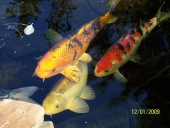




















doughpat wrote:
I've always had this grand idea of pairing fossil-fuel power plants with greenhouses. It only makes sense--the waste products of one (CO2, H20 and heat) are the feedstocks of the other. Then my pessimistic side says, "If that worked, someone would have done it by now". I wonder how many brilliant ideas are delayed by that mantra....
Ryan Lenz














TCLynx




It looks like it should be possible to build your own set up for quite a bit less than the Aussie guy sells his for. I would use gravity-feed as much as possible (our land has a slight slope, so I should be able to set up a gravity-feed system with a solar pump to return the water).
I'm thinking maybe ferro-cement, but would that be okay for the fish?
And it looks like it should be possible to add some other things to the system, like ducks and rabbits. Chickens? Earthworm beds? Beds of marsh-loving perennials following the annual vegetables? What else? How to optimize production and minimize inputs?
I'm thinking of setting it up in a manner similar to a gray-water purification system....
Check out my Primal Prepper blog where I talk about permaculture, prepping, and the primal lifestyle... all the time! 








And it looks like it should be possible to add some other things to the system, like ducks and rabbits. Chickens? Earthworm beds? Beds of marsh-loving perennials following the annual vegetables? What else? How to optimize production and minimize inputs?

TCLynx








 ) This way you can keep things simple enough to keep things balanced yet harness the nutrients in their waste. Then again, if you have enough space and can simply put in a real pond, it could be a moot point.
) This way you can keep things simple enough to keep things balanced yet harness the nutrients in their waste. Then again, if you have enough space and can simply put in a real pond, it could be a moot point.TCLynx




 2
2






TCLynx
 1
1




TCLynx




TCLynx
 2
2









Idle dreamer






Idle dreamer





Idle dreamer









Idle dreamer





Idle dreamer






Idle dreamer








When I collect the crap runoff from the fish tank is it sufficient to collect it from the top? It floats? I don't need to vacuum the bottom? Any bottom will do or do I need several inches of stone?
Tilapia are tropical so it doesn't matter how hot the water gets in my Florida tank?
What about on freezing nights?
I read and reread above that scum algae uses the oxygen that the fish need so I want to avoid it but what if I have another dirty tank using human sewage for the growth medium. How big would that tank have to be to grow enough algae to feed the fish?
What is a good size for 250 1 lb tilapia?
I saw a tube where they fish crap runoff is kept for five days for the nitrogen to set.
I can eat lettuce but there are no calories for me or my chickens. Can corn be grown easily or is it difficult for some reason? Would it be better to plant corn in the ground and use a drip heavy in particulate? Wouldn't a drip line with crap in it plug often?
Should I order stock fingerlings all male or should I include a few females or does it matter?

I planted my garden very late to take advantage of the summer rain but then got no fruits on the tomatoes, the squash and the cucumbers although they flowered. Was it because they were out of the normal grow cycle? Rabbits may have got to them so I am not sure. Does seasonal cycle matter in grow beds that don't freeze and have some sun?

Idle dreamer























Idle dreamer




H Ludi Tyler wrote:
Wow! You're very fortunate to have that large "tank"!

 I already have fish started in it and it holds temp and water very well, I plan on making the seed starting area above it and between the "tank" and house will be the nursery greenhouse. Cant wait to have it all done but it does take some time as you all know
I already have fish started in it and it holds temp and water very well, I plan on making the seed starting area above it and between the "tank" and house will be the nursery greenhouse. Cant wait to have it all done but it does take some time as you all know  Wish the permie powers that be would make a section just for aquaponics
Wish the permie powers that be would make a section just for aquaponics















http://www.breezymeadowsorchards.com/learn/permaculture-design-course
Breezy Meadows orchard & Nursery Permaculture Design Course. Join us at our permaculture farm in the wilds of Tinmouth, VT. Hands on experience on a working farm that produces food 365 days a year.
 1
1




jbreezy wrote:
Im sure there is a way to make it work out so the pros heavily outweigh the cons hopefully someone here can point them out to me.

Idle dreamer





Idle dreamer










|
Ever since I found this suit I've felt strange new needs. And a tiny ad:
The new gardening playing cards kickstarter is now live!
https://www.kickstarter.com/projects/paulwheaton/garden-cards
|
.jpg)




